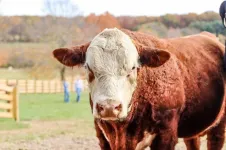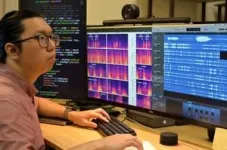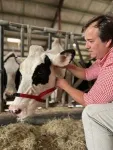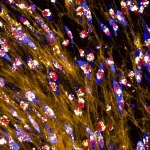(Press-News.org) You may not know it, but cows share information every time they burp, moo, and chew that speaks volumes about their health and welfare.
Through the work of researchers in Virginia Tech’s College of Agriculture and Life Sciences, we may soon know more about what cows are “telling” us and be able to use that information to improve their well-being.
James Chen, an animal data sciences researcher and assistant professor in the School of Animal Sciences is using a $650,000 grant from the U.S. Department of Agriculture's National Institute of Food and Agriculture to develop an acoustic, data-driven tool to help enhance animal welfare and lower methane emissions in precision livestock farming.
“Vocalization is a major way cows express their emotions, and it is about time to listen to what they’re telling us,” Chen said.
Because sound data can be collected from cows individually and continuously, Chen said it’s better than video or other observation methods for monitoring cows’ emotions and health, including even subtle changes in breathing.
“The assessment of animal welfare has become a central discussion in society and is a controversial issue simply because the lack of objective tools leads to biased interpretations,” he said. “By matching audio data with biological and visual cues, we can be more objective in our approach to analyzing their behavior.”
Using artificial intelligence to interpret moos
Chen and his co-investigator, Virginia Cooperative Extension dairy scientist and Associate Professor Gonzalo Ferreira, plan to collect audio data from cows, their calves, and beef cattle in the pasture. They will then use machine learning to analyze and catalog thousands of points of acoustic data and interpret cow vocalizations such as mooing, chewing, and burping for signs of stress or illness.
“Let’s think about a baby crying inside a plane or in church,” Ferreira said. “As a father, I have an idea whether the baby is crying because it’s hungry or wants attention. Our research question then is: Can we use audio data to interpret animals’ needs?”
Chen and Ferreira are particularly interested in identifying vocal patterns for how cows’ communicate distress. By analyzing the frequency, amplitude, and duration of cow’s moos and vocalizations and correlating the sound data with saliva cortisol samples taken from the cow, they can classify whether cows are experiencing no stress, mild stress, or severe stress and begin to decode their “language.”
As part of the project, Chen is building a computational pipeline that integrates acoustic data management, pre-trained machine-learning models, and interactive visualization of animal sounds. The resulting data will be shared in an open-source, web-based application available to scientists, producers, and the public. Chen said his hope is that the information will help guide future protocols to improve animal welfare.
“Anyone can directly plug in and use our model to run their own experiment,” he said. “This allows people to transform cows’ vocalizations into interpretable information that humans can recognize.”
Researchers plan to place small recording devices on the halters or collars of cows to capture their vocalizations for the study. Here, Dairy scientist and Associate Professor Gonzalo Ferreira fastens a halter outfitted with a tiny recorder to a dairy cow. Photo courtesy of Gonzalo Ferreira.
Decoding burps
Because cows’ burps can release small amounts of methane, the researchers also will try to identify cows that burp less through audio data. By comparing the sound data to DNA samples from the cows, they hope to understand whether a genetic variant causes some cows to burp more than others. They also plan to examine the impact of rumen modifiers — food additives that inhibit methane gas production — to gauge the effects.
“Measuring methane emissions from cattle requires very expensive equipment, which would be prohibitive to farmers,” Ferreira said. “If burping sounds are indeed related to methane emissions, then we might have the potential for selecting low methane-emitting animals at the commercial farm level in an affordable manner.”
“Our eventual goal is to use this model on a larger scale,” Chen said. “We hope to build a public data set that can help inform policy and regulations.”
END
What if cows could talk?
By using acoustic data and machine learning to decipher cows' vocalizations, Virginia Tech researchers hope to shed new light on the animals' health, welfare, and environmental impact.
2024-01-16
ELSE PRESS RELEASES FROM THIS DATE:
Allen Fawcett named Director of the Joint Global Change Research Institute
2024-01-16
By Greg Koller
COLLEGE PARK, Md.— Allen Fawcett — an energy expert and economist who has played a leading role in formulating and coordinating U.S. climate policy — is the new director of the Joint Global Change Research Institute.
Fawcett joined the Environmental Protection Agency in 2003 and, since 2012, served as the chief of EPA’s Climate Economics Branch, which advances the science of climate economics to inform policy. From 2010 to 2011, Fawcett took leave from EPA to serve as the deputy associate director for energy ...
Parents more likely to attempt suicide in first years after child’s cancer diagnosis
2024-01-16
Parents who have a child with cancer are more likely to attempt suicide during the first years after diagnosis, according to a new study conducted by Qianwei Liu of Southern Medical University, China, and colleagues, published January 16th in the open access journal PLOS Medicine.
Receiving a cancer diagnosis for a child is an incredibly stressful and distressing experience for parents. These parents, especially mothers, face an increased risk of psychiatric disorders, but little is known about the risk of suicide. In the new study, researchers looked at the number of suicide attempts ...
Energy-starved breast cancer cells consume their surroundings for fuel
2024-01-16
New study from the University of Sheffield identifies a novel mechanism employed by breast cancer cells to survive in the challenging environment within tumours
The findings provide a new insight into a previously unknown mechanism of cancer cell survival and may offer a new target for developing therapies
The research found breast cancer cells take advantage of nutrients in the extracellular matrix in times of nutrient starvation
Energy starved breast cancer cells ingest and consume their surroundings to overcome starvation, a new study has found.
The research, conducted by scientists at the University of Sheffield and published today (Tuesday 16 January ...
How did free wi-fi help unlock Hanoi wet markets’ mysteries?
2024-01-16
Researchers at the Alliance of Bioversity International and CIAT and their collaborators have been working on how to harness the power of the estimated 549 million Wifi hotspots worldwide, resulting in a project that used anonymized data gathered from free Wi-Fi to better understand the impact of COVID-19 on Hanoi’s wet markets during the first stage of the Covid-19 pandemic.
In the paper “Using free Wi-Fi to assess impact of COVID-19 pandemic on traditional wet markets in Hanoi” published in December 2023 in the scientific journal Food Security, the researchers analyzed and interpreted mobile device tracking ...
Smooth operation of future nuclear fusion facilities is a matter of control
2024-01-16
As researchers around the world work to develop viable alternatives to fossil fuels, the prospect of nuclear fusion—harnessing the same energy-generating reactions that power the sun—has grown increasingly attractive to private equity firms.
In 2022, the U.S. Department of Energy launched a partnership with investors in the private sector to accelerate the development of fusion energy, in part through the development of a fusion pilot plant, or FPP, in the United States.
The FPP and ITER—the world’s largest nuclear fusion reactor, currently being ...
Microfossils shed light on the long fossil record of euglenoids
2024-01-16
Hiding in the shadows, euglenoids are a fascinating group of single-celled protists that are neither plant nor animal. Plants photosynthesize, and animals eat. Euglenoids do both. Spiraling along the murky bottoms of shallow fresh-water ponds with their long flagella, they eat organic goop, while also using their chloroplasts to convert CO2 and water with light into sugars. Because of this in-between status, euglenoids have been placed close to the very base of the eukaryotic branch on the tree-of-life that includes ...
Amnesia caused by head injury reversed in early mouse study
2024-01-16
WASHINGTON - A mouse study designed to shed light on memory loss in people who experience repeated head impacts, such as athletes, suggests the condition could potentially be reversed. The research in mice finds that amnesia and poor memory following head injury is due to inadequate reactivation of neurons involved in forming memories.
The study, conducted by researchers at Georgetown University Medical Center in collaboration with Trinity College Dublin, Ireland, is reported January 16, 2024, in the Journal of Neuroscience.
Importantly for diagnostic and treatment purposes, the researchers found that the memory loss attributed to head injury was not a permanent pathological event driven by ...
Domesticating plants impacts their microbiome, study finds
2024-01-16
New research led by the University of Oxford indicates that human domestication of crops can alter the communities of microorganisms that are associated with plants. Intriguingly, independent domestication events were found to have similar impacts on the plant microbiome. The results have been published today in Current Biology.
Lead researcher Dr Riccardo Soldan (Department of Biology, University of Oxford) said: 'Our study provides evidence that regardless of where and how domestication took place, domesticated ...
Reductive carboxylation of glutamine as a potential target in AML
2024-01-16
“Identification and validation of novel and targetable metabolic weaknesses in AML is ongoing.”
BUFFALO, NY- January 16, 2024 – A new editorial paper was published in Oncotarget's Volume 14 on December 1, 2023, entitled, “Reductive carboxylation of glutamine as a potential target in acute myeloid leukemia.”
In this new editorial, researchers Alessia Roma, Lawrence D. Goodridge and Paul A. Spagnuolo from the University of Guelph discuss acute myeloid leukemia (AML) — an aggressive cancer of the blood and bone marrow ...
Identity concealment in sexual minority men may have impeded mpox care
2024-01-16
ITHACA, N.Y. – Openly gay, bisexual and other sexual minority men were more likely than those who conceal their sexual orientation to seek care for mpox during a global outbreak of the disease last year that disproportionately affected their community, researchers from Cornell University and the University of Toronto found.
It wasn’t necessarily concern over being “outed” that kept some sexual minority men from seeking care for the disease, formerly known as monkeypox. According to the researchers, it was an information gap, partially attributable to separation from community due to identity concealment.
“The resource knowledge and community-connected ...
LAST 30 PRESS RELEASES:
Why nail-biting, procrastination and other self-sabotaging behaviors are rooted in survival instincts
Regional variations in mechanical properties of porcine leptomeninges
Artificial empathy in therapy and healthcare: advancements in interpersonal interaction technologies
Why some brains switch gears more efficiently than others
UVA’s Jundong Li wins ICDM’S 2025 Tao Li Award for data mining, machine learning
UVA’s low-power, high-performance computer power player Mircea Stan earns National Academy of Inventors fellowship
Not playing by the rules: USU researcher explores filamentous algae dynamics in rivers
Do our body clocks influence our risk of dementia?
Anthropologists offer new evidence of bipedalism in long-debated fossil discovery
Safer receipt paper from wood
Dosage-sensitive genes suggest no whole-genome duplications in ancestral angiosperm
First ancient human herpesvirus genomes document their deep history with humans
Why Some Bacteria Survive Antibiotics and How to Stop Them - New study reveals that bacteria can survive antibiotic treatment through two fundamentally different “shutdown modes”
UCLA study links scar healing to dangerous placenta condition
CHANGE-seq-BE finds off-target changes in the genome from base editors
The Journal of Nuclear Medicine Ahead-of-Print Tip Sheet: January 2, 2026
Delayed or absent first dose of measles, mumps, and rubella vaccination
Trends in US preterm birth rates by household income and race and ethnicity
Study identifies potential biomarker linked to progression and brain inflammation in multiple sclerosis
Many mothers in Norway do not show up for postnatal check-ups
Researchers want to find out why quick clay is so unstable
Superradiant spins show teamwork at the quantum scale
Cleveland Clinic Research links tumor bacteria to immunotherapy resistance in head and neck cancer
First Editorial of 2026: Resisting AI slop
Joint ground- and space-based observations reveal Saturn-mass rogue planet
Inheritable genetic variant offers protection against blood cancer risk and progression
Pigs settled Pacific islands alongside early human voyagers
A Coral reef’s daily pulse reshapes microbes in surrounding waters
EAST Tokamak experiments exceed plasma density limit, offering new approach to fusion ignition
Groundbreaking discovery reveals Africa’s oldest cremation pyre and complex ritual practices
[Press-News.org] What if cows could talk?By using acoustic data and machine learning to decipher cows' vocalizations, Virginia Tech researchers hope to shed new light on the animals' health, welfare, and environmental impact.








